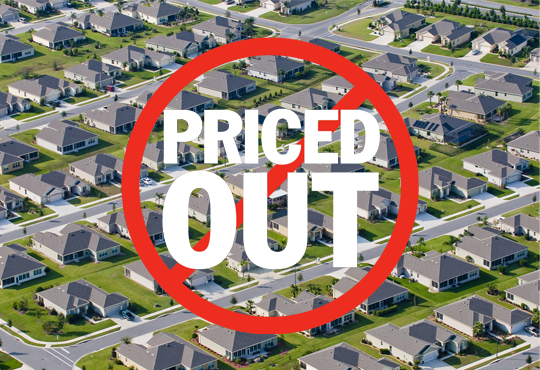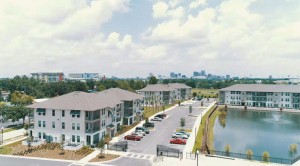Priced Out
 Central Florida has found itself amid an affordable housing crisis that may only get worse before it gets better.
Central Florida has found itself amid an affordable housing crisis that may only get worse before it gets better.
Recently, Shelley Lauten, CEO of the Central Florida Commission on Homelessness, received an email from a local woman who works at a major hospital. It was one of many emails she receives from people who are at the end of their rope, wondering what else it is they need to do to survive.
The woman said she is working as much over-time as possible but is barely able to afford a place to live. Each year at the hospital, she receives a 2 percent raise. But over the past five years, her rent has increased more than 5 percent every year.
“She’s just on this losing treadmill,” Lauten says.
For a lot of Orlando workers, this story rings all too true.
According to a survey conducted by the Regional Affordable Housing Initiative, a partnership among Orange, Seminole and Osceola counties and the city of Orlando, one in every three homes in Central Florida is cost-burdened, meaning the residents spend more than 30 percent of their income on housing.
Nationally and in Central Florida, a home is considered “affordable” if it eats up only 30 percent or less of the resident’s income.
The reasons for this disparity between the cost of housing and what people can actually afford are manifold.
But it all starts with the simple fact that there is just not enough housing for the number of people who live here.
“We just flat out don’t have enough units,” Lauten says. “That’s first and foremost.”
A Schism Between Supply and Demand
For anyone who’s taken a drive outside city limits to the subdivisions that have taken over every inch of space in Central Florida, it’s hard not to see how much of the area is full of homogenous houses in the same palate of colors on the same lot sizes.
Before this style of building was adopted, families would instead buy a customized lot of land themselves and then build a house that fit their family and their budget, instead of developers buying the land and then selling identical lot sizes and pre-designed homes as a bundle.
One outcome of this latter 20th-century way of building is houses have substantially increased in size.
Today the average new-build house is 2,630 square feet and houses just 2.54 people. In 1973, the average size of a newly built house was about 1,660 square feet and housed 3.01 family members, according to 2017 data from the U.S. Census Bureau.
“So, we’ve grown bigger houses and housed fewer people in them,” Lauten says. “And the costs just keep going up and up and up. … That’s where we’ve caused this real gap between suburban housing and options for people who can’t afford that much space or can’t afford the kind of housing we’re building.”
This mismatch means that people with less money to spend on housing have an even smaller pool of choices because not many developers are building smaller homes to fit lower incomes.
Eddy Moratin, executive director of Lift Orlando, has noticed this trend as well.
“There is almost no one, I would dare to say, no one developing starter home communities anymore,” Moratin says. “There’s too much to be made in sort of the second [and] third upgrade homes.”
Lift Orlando is a nonprofit run by business leaders who are working to revitalize neighborhoods by partnering with residents and local stakeholders.
The nonprofit has been on the forefront of addressing the affordable housing problem. This year it opened Pendana at West Lakes, a new apartment complex that was built to offer residents affordable homes and to help revive the neighborhoods next to Camping World Stadium.
Moratin and his team were overwhelmed by the response they received for a complex that has just 200 units.
“In the end, it was about 10,000 people that inquired about living there,” he says, “which really was not something any of us expected or were ready for.”
Segregated by Gated Communities
Pendana was not solely designed as a low-income housing development. In fact, only 70 percent of the units are being made affordable by low-income housing tax credits. Twenty percent of the units were rented out at market rate, while 10 percent were prioritized for people who are extremely low income or who are using Section 8 housing vouchers.
This mixed-income housing was Lift Orlando’s intention.
“It used to be that our neighborhoods were integrated economically,” Moratin says. “We’ve become segregated by the gated communities that we can afford.”
 By having a mix of people of various incomes, Pendana can hopefully stave off the disinvestment and neglect that happens over time for a lot of low-income apartments.
By having a mix of people of various incomes, Pendana can hopefully stave off the disinvestment and neglect that happens over time for a lot of low-income apartments.
Moratin cites an anecdote from Alzo Reddick, director of Defense Transition Services at the University of Central Florida and a former state house representative, as an example of what economically integrated neighborhoods can do. Reddick grew up in the same neighborhood that Pendana is located in now when the area was still thriving. He had a diversity of neighbors from working class to lawyers and teachers.
“Something about that environment as a child told him he could be any of those things, seeing the diversity of achievement on professional levels,” Moratin says.
As Downtown Orlando’s redevelopment stretches to the west, complexes like Pendana are a life preserver thrown to the most vulnerable among us.
“If you just let unbridled development move westward, all these families end up vulnerably displaced out of the inner city,” Moratin says. “They can’t afford the suburbs either. So, in Orlando, most end up in the weekly-monthly motels outside of town.”
The Gap Widens
It’s not just that Central Florida has a lack of appropriately sized and centrally located housing.
In America, despite the strong labor market, wage growth has been mostly flat, after adjusting for inflation. Furthermore, wage gains that have been made have largely gone to the highest earners, according to data from the U.S. Bureau of Labor Statistics.
Even with these numbers at hand, many people still believe affordable housing isn’t about them. Moratin says part of the issue is the term “affordable housing” has a connotation to it that makes most people believe it applies to only a certain class and color.
“We have improper definition of who affordable housing is for because we only think it’s people of a certain color or an extremely low income,” he says. “The reality is, where is the server, the cook, the teacher starting out supposed to live? Where is the college student or the recent grad supposed to live? … So, it’s really thinking about the broader spectrum of people—often with an education.”
Beyond wages, Lauten says the rising costs of health care, child care and transportation have made it so what gains workers have made in wages are being immediately expunged.
“We have a complicated interrelationship with cost,” she says. “And the gap associated with those costs is getting wider and wider.”
It becomes an impossible puzzle for people to solve. If they can’t afford to live here, then maybe they could move farther away from Central Orlando? But then they’re commuting longer to work and spending more and more on transportation.
For workers who are receiving subsidies for child care or housing, it’s an even more complicated game of balance where trying to move up can actually set them back.
“We’ve had anecdotes of people having to turn down a $1 an hour raise because it moves them in to a category where they just lost a benefit they can’t make up with $1 [more] an hour,” Lauten says. “So, we are penalizing people for wanting to move ahead.”
To fix this problem, advocates have lobbied for state legislators to dole out benefits based on a sliding scale, instead of cutting people off at a certain number.
Not an Overnight Solution
The solutions to Greater Orlando’s affordable housing problem are systematic and complex, a tangled mess of multiple issues that need to be solved before we’ll see housing costs go down.
“This is one of those issues that can seem so big that it might seem daunting,” Shannon Nazworth, executive director of Ability Housing, says.
Ability Housing, a Jacksonville-based nonprofit, works to provides quality, affordable housing for those who need it. The organization first came to the Orlando market after being solicited by the Central Florida Commission on Homelessness.
In April, the group broke ground on its first Orlando property called Village on Mercy, which will have 166 units restricted to residents who are earning 60 percent or less of the area’s median income.
The nonprofit is also renovating an existing housing complex located on the edge of Maitland, changing it from transitional housing to 77 high-quality apartments. Fifty percent of those units will be reserved to be used as permanent supportive housing for the homeless.
Additionally, the city of Orlando is working to revise city codes that could allow the private sector to add more housing including updating the standards for small apartment buildings and laxing the rules around the building of accessory dwelling units, which are sometimes called “granny flats.” Accessory dwelling units are small apartments that are built atop detached garages or in homeowners’ backyards that in the past many families would use to house a grandparent but today are often rented out.
On a state level, there are two affordable housing funds that are supported by a tax on real estate transactions.
These trust funds are used to pay developers to build subsidized apartments. Some of the money is also given to local governments to use on housing incentives such as down payment assistance.
But the Florida Legislature has continually raided those funds to pay for other things for 14 of the last 18 years, totaling nearly $2.2 billion since 2001.
All the while, things have only gotten worse and worse.
“Real estate is getting more expensive and wages just aren’t keeping up,” Nazworth says. “I know that many of the jurisdictions are really focusing on this and working hard to address the challenge but it’s not going to be able to turn around overnight.” Although it’s an enormous and complicated problem, Nazworth is optimistic.
“Every little piece of action helps get you to the finish line,” she says. “The sooner we get working on it, the sooner we’re going to see positive outcomes.”
This article originally appeared in Orlando Family Magazine’s October 2018 issue.









